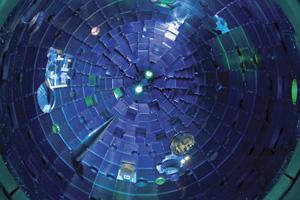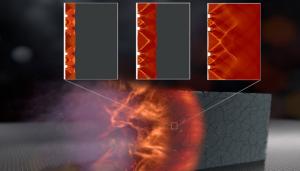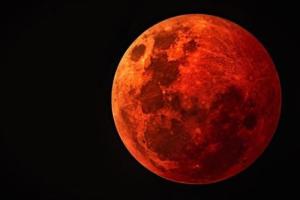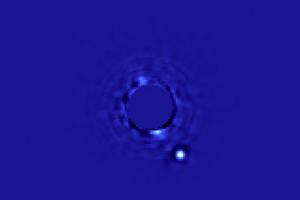LAB REPORT
Science and Technology Making Headlines
March 10, 2017


Target Area Operations technicians Anthony Ybarra and Sky Marshall enter the NIF Target Chamber facility to modify the first wall panels at the polar diagnostic instrument manipulator (DIM) to provide it with a greater range of motion. Photo by James Pryatel/LLNL
From fire to fusion
Humankind has moved from creating fire in the earliest of days to creating a sun on Earth.
Experts at Lawrence Livermore’s National Ignition Facility are working to harness the power of the sun in the laboratory. It’s the next great step in humanity’s relationship to fire: thermonuclear fusion.
But the biggest challenge is making fusion work.
That’s where LLNL scientists come in using the world’s largest laser.


A 3D rendering of an exploding foil initiator.
It’s a blast
Lawrence Livermore scientists and collaborators at Los Alamos National Laboratory for the first time have taken 3D snapshots of operating high explosive detonators.
Scientists from LLNL, Los Alamos and National Security Technologies, LLC (NSTech) combined state-of-the-art imaging capabilities with computed X-ray cross-sectional reconstruction in experiments performed at the Argonne National Laboratory's Advanced Photon Source to generate 3D snapshots of exploding foil initiators (EFI).
Exploding foil initiators, also known as slapper detonators, offer safety and timing advantages over other means of initiating high explosives. However, understanding how detonators perform is challenging.


Lawrence Livermore scientists studied low-level stratocumulus clouds to identify their effects on global warming.
A cloudy outlook on global warming
Clouds play a significant role in Earth’s climate system by reflecting incoming sunlight and reducing outgoing heat. As Earth’s oceans and other surfaces warm, how clouds handle light and heat changes.
Lawrence Livermore scientists examined how the changes in clouds, in turn, influence the climate system. They showed how cloud variations induced by changes in the areas of warm and cooler sea surface temperatures have contributed to climate. They also showed that the changes to the clouds have had a cooling effect in response to recent climate change.


NASA had to move its Mars-circling satellite Maven to avoid a collision with Phobos, Mars’ lumpy, crater-filled moon.
Close call with the death star moon
A NASA science satellite orbiting Mars was forced to make a rare evasive maneuver to avoid a collision this week with Phobos, one of the planet's two small moons.
NASA sped the satellite’s’ boost up about 1.3 feet per second. While the shift may seem small, it’s enough to ensure that it avoided crashing into Phobos by about 2.5 minutes.
Phobos has a “death star” shape and calculations by physicists from Lawrence Livermore National Laboratory reveal Phobos could have survived a major impact, which left behind a massive crater.


This image of a 10-million-year-old planet called Beta Pictorus b was captured by the Gemini Planet Imager..
We’re hunting planets
A giant camera in Chile has taken snapshots of a 10-million-year-old planet called Beta Pictorus b, located around 63 light years from Earth, orbiting around its giant parent star. Images like this one are poised to become much more common, thanks to the launch of the Gemini Planet Imager (GPI), which will vastly improve the ability to detect far-off planetary systems.
GPI, a collaborative international effort among institutions including NASA, Lawrence Livermore National Laboratory, and the University of California, Berkeley, has been in development for nearly a decade. Researchers earlier this month unveiled the camera’s first shots of distant planets, which were snapped from the Gemini South telescope in Chile this past November.
The instrument is specifically designed to detect infrared radiation (allowing it to readily spot young planets still glowing brightly from their formation) and actually “masks” light emitted by parent stars that would otherwise block or distort a planet. Researchers estimate that it’s about 10 times more sensitive than previous instruments, and will able to spot and capture an exoplanet’s image within minutes — rather than days.





